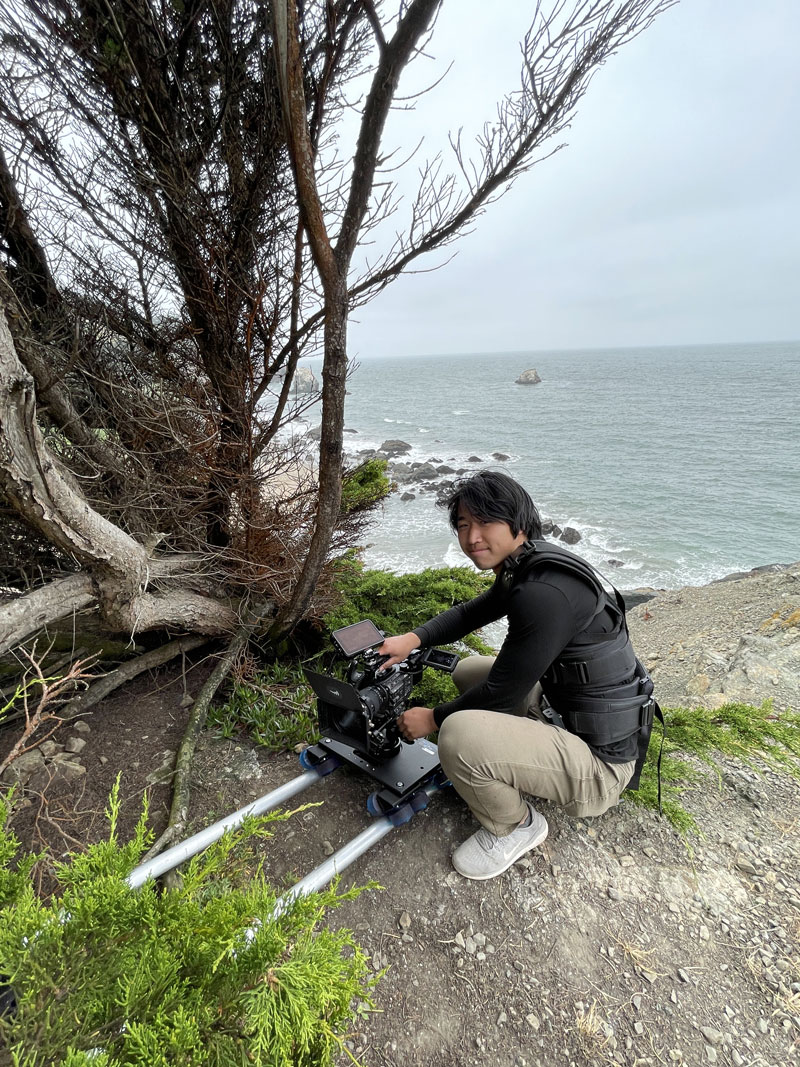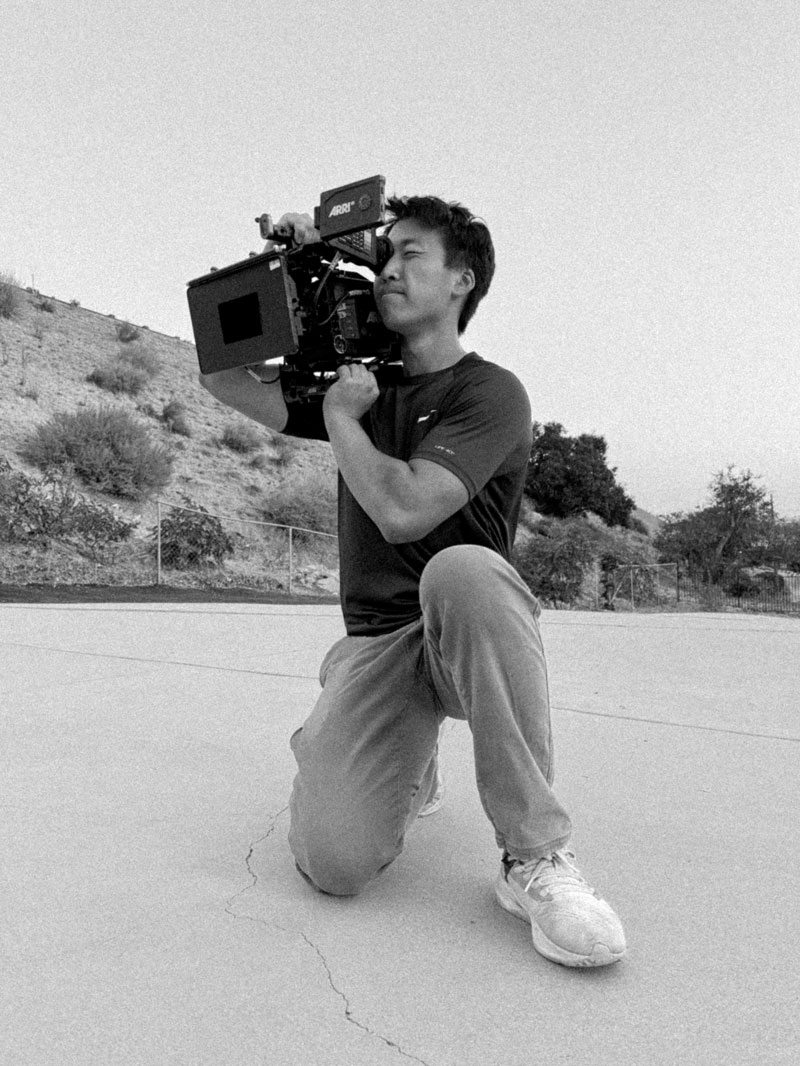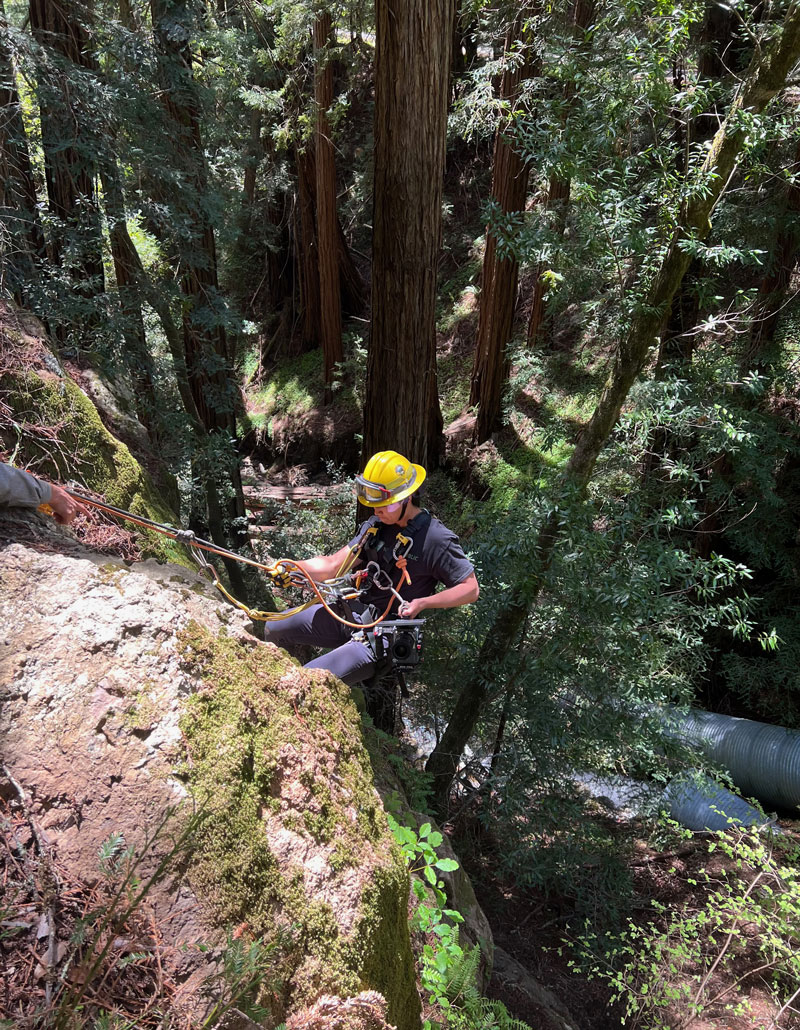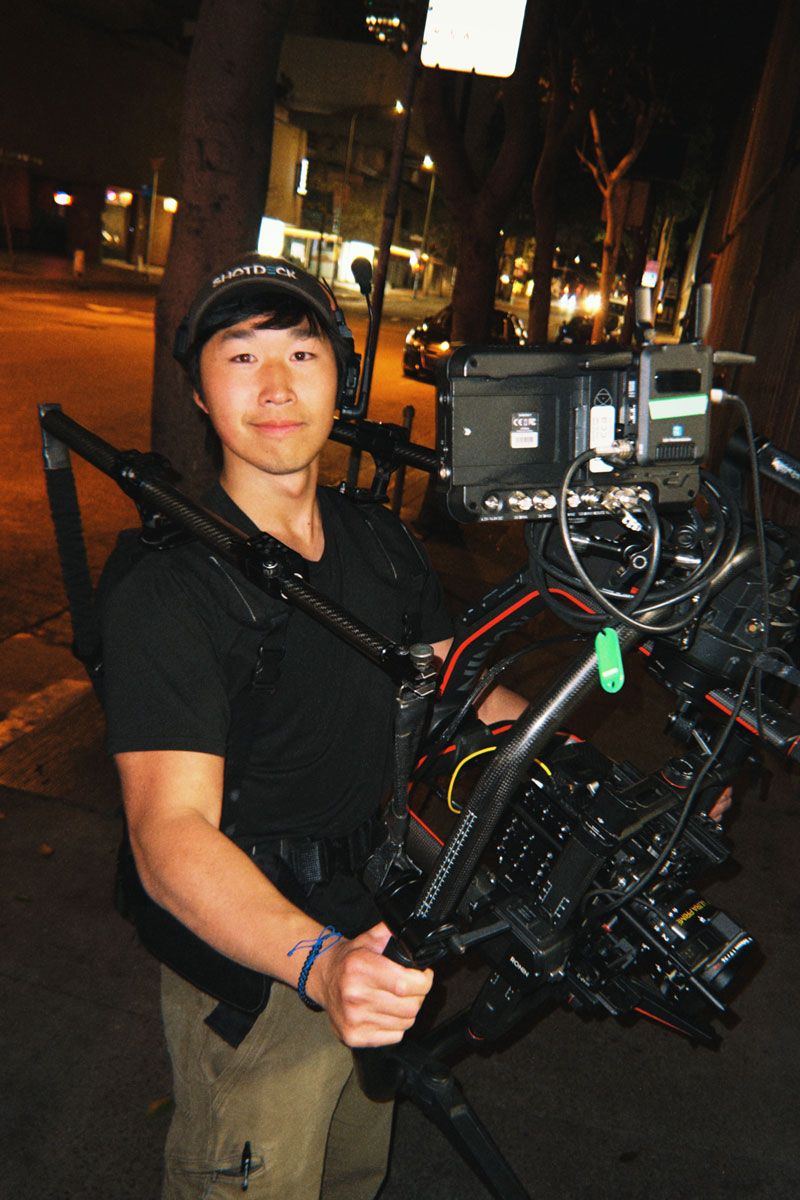
Zeng works behind the scenes on Lands End, a feature-length film produced by CAP Club in 2023.
UC Berkeley may be known for its strength in research, but for third-year environmental economics and policy major Steven Zeng, coming to Berkeley provided him with a community to pursue his true passion: film.
“Film is always on my mind,” said Zeng. “Through film, you’re able to see the world in a different way. And once that lever gets switched on, it doesn't really switch off.”
Since starting at UC Berkeley, Zeng has gotten involved in the Cinematic Arts and Production Club, which seeks to provide undergraduates passionate about the cinematic arts with a production-driven community that fosters collaboration. As a director of photography affiliated with the group, Zeng helps take the creative vision of writers and directors from the page to the screen through visuals and technical direction.
Rausser College spoke to Zeng about his journey to UC Berkeley, his love of film production, and his creative process.
This conversation has been edited for length and clarity.
Describe your journey to UC Berkeley?
I got rejected from all the colleges I applied to during my senior year of high school. It was a big shock to me, and not something I had planned for. I thought I could start at community college for a bit, but it wasn’t something I really wanted to do because this was around the height of the COVID lockdown era, and I was kind of tired of sitting on Zoom in school.
Ultimately, I decided that I wanted to take some time and work. My brother works in the film industry, and I did some photo stuff in middle school and high school—mostly small photo shoots or event coverage—so I called him and told him that I’d be willing to help him out with anything. He invited me to stay with him and work. I spent about five months in total with him working on sets for commercials, music videos, and short films in New York.
After leaving New York, I spent three months in the Mojave Desert working on a trail crew with the Student Conservation Association. We were based in Ridgecrest, CA, but would go out to state and national parks or even lands managed by the Bureau of Land Management for 10 days at a time to do manual labor such as putting up fences in the desert or getting rid of graffiti in a ghost town..
After a few months back home in Texas, I ended up getting a job in Homer, Alaska, which is a beautiful area right at the seat of Kachemak Bay State Park. That was the coolest summer of my life, and when that ended, I came down to Berkeley to start school.

Zeng on the set of a Los Angeles production last Fall.
What was the application process like?
I was actually in the Mojave Desert when I applied to Cal. We didn’t have any electricity in the field, so I'd write my admissions essays in a journal and then, during my days off, go to McDonald's to type them up because their WiFi was better than the public library's.
I hadn’t even applied to Berkeley during my first round of applications, but I feel so lucky to be here now, especially since the programs are really great. The location can’t be beat: you have mountains two hours away, a beach right in San Francisco, and flat grasslands to the south.
What has been the highlight of your time at Berkeley?
I came in as an environmental science major because the program was really great and have since changed to environmental economics and policy. I’m also pursuing minors in data science and journalism. Journalism has been really interesting to learn since I'm used to shooting narrative work, which has a script that guides the story from start to finish. Unscripted content like documentary work is so different, because you don't know what path or branch your story will take. As a result of that, you might not immediately know how a story will end because, six months later, something might pop up and work as the perfect conclusion.
I knew that film would be a part of my life when I started school, but didn't know to what extent it would be. Out of all the organizations I've joined here at school, the Cinematic Arts and Production (CAP) Club has defined me the most. We’re a very bootstrapped group, if that makes sense—we don't have a lot of resources due to limited club funding, and on top of that, film production is inherently expensive. But the people are so dedicated and talented. Their ability to make magic out of nothing is unbelievable—it’s almost like they have a Philosopher's Stone. You give them 300 dollars and they'll somehow schedule a 10-day shoot with a full art department, source decent camera gear, and produce a 15-minute film.
What role do you play in a film?
I’m a director of photography, which is a fancy way of saying cinematographer or glorified cameraman. As a cinematographer, I’m in charge of taking the director's creative vision and making that into something you can see. I get a script, read it, and then start pitching ideas to the director about shots or lighting references. Sometimes I’ll operate the camera during production and guide my G&E team through the day’s setups, while other times I might talk with the art department about costumes and how that affects the color contrast of a scene. I also do a bit of color grading work because I like the amount of control I have over the film’s final visuals.
It's cool seeing the shoot come together. Being on set is one of the most fun things in the world, but it's also a bit intense. You and your crew are working together against time and money to tell the story and—in my case—make the most beautiful image possible. And once it’s all done, the film goes off to a small screening where we get to talk to people about it.

With the help of local firefighters, Zeng scales a cliff in Marin County while filming a shot.
Where do you find inspiration?
In terms of my philosophy of how to shoot, I take a lot from Roger Deakins (Blade Runner 2049, 1917), who starts with the story and script. If it's a story that speaks to him and that he wants to tell the world, then he'll go accept the project. I also take a lot of inspiration from cinematographer Rina Yang, who started off with music videos (she’s done a few for Taylor Swift) but is now working on long-form narrative content. I really admire her ability to work with people on set, because you can have strong technical ability or good taste, but if you're not able to talk to your director or people working with you, then your idea is not going to get executed.
Generally, I try not to limit my creative inspiration to film, because it can get redundant. I try to take inspiration from life in general—like how the light might be hitting off a tree and gets divided on a wall, or the different textures that appear around you, and even bits of color theory.
How many projects have you been a part of?
With CAP, I’ve been a part of seven projects, but have indirectly helped on a couple more during my three years at Cal. In 2024, I worked on around 51 projects—almost like a project a week. I try to make time where I can.
But working in film is very different than your average nine-to-five job. Stability is not guaranteed, and realizing that has resulted in me pushing myself forward. The advice I was given was that I should be meeting two to three creative individuals a week, so a lot of the time we chat over coffee and see if our vibes match to plant seeds for work. They might not reach out immediately, but a year or two down the line, they might have a job for me.
Have they helped grow your skills?

A behind-the-scenes photo of Zeng from a recent shoot with a few of his San Francisco film friends.
I take a different lesson from each project I’ve worked on. The project that made me realize that I have to step up my game was this feature I shot called Lands End. That was the summer after my freshman year, and it felt like a really big shoot at the time—it went for 22 days, we worked long hours, and I actually had a full crew working with me. The shoot taught me how to lead a crew: I couldn’t be doing everything myself or letting them just stand by. I also learned how to manage my stress and to communicate my ideas better.
I’ve picked up some technical stuff on more of my recent sets. Berkeley is a great research school—we’re not a big film production school, so we don't have really good gear available to students. On the bigger sets in Los Angeles or New York that I’ve had the chance to work on, we’ve had actual gear like Fisher dollies and cranes.
I worked on four shoots in Los Angeles last fall for a couple of narrative shorts and a spec ad, which is almost like a type of portfolio piece. It was great to know that people want my skills, and that they’re willing to spend money on me as talent, which has really pushed me to refine my creative skills and craft.
Are there other groups you’ve been involved with?
I worked on the Daily Cal’s multimedia team for two semesters because I was interested in journalism. I got to learn how a news organization works—but I ultimately realized it wasn’t for me. Outside of CAP, I'm part of the Data Science Society on campus and taught their DeCal course for a couple of semesters. It’s a wonderful group of friends who offer me different insights and perspectives that aren’t as related to film.
Recently, I’ve spent a lot of time enjoying nature. There is a group that watches the sunset at the Campanile, and I’ve recently joined them. This semester is my break semester. I’m taking in more of life, spending time with people, appreciating their company, and the time we spend together. I want to incorporate that warmth and care into my film life, so I can do that on set.
Do you know of a student or group in Rausser College involved in noteworthy research, community outreach, or extracurricular activities? Let us know by submitting a suggestion with this nomination form.
